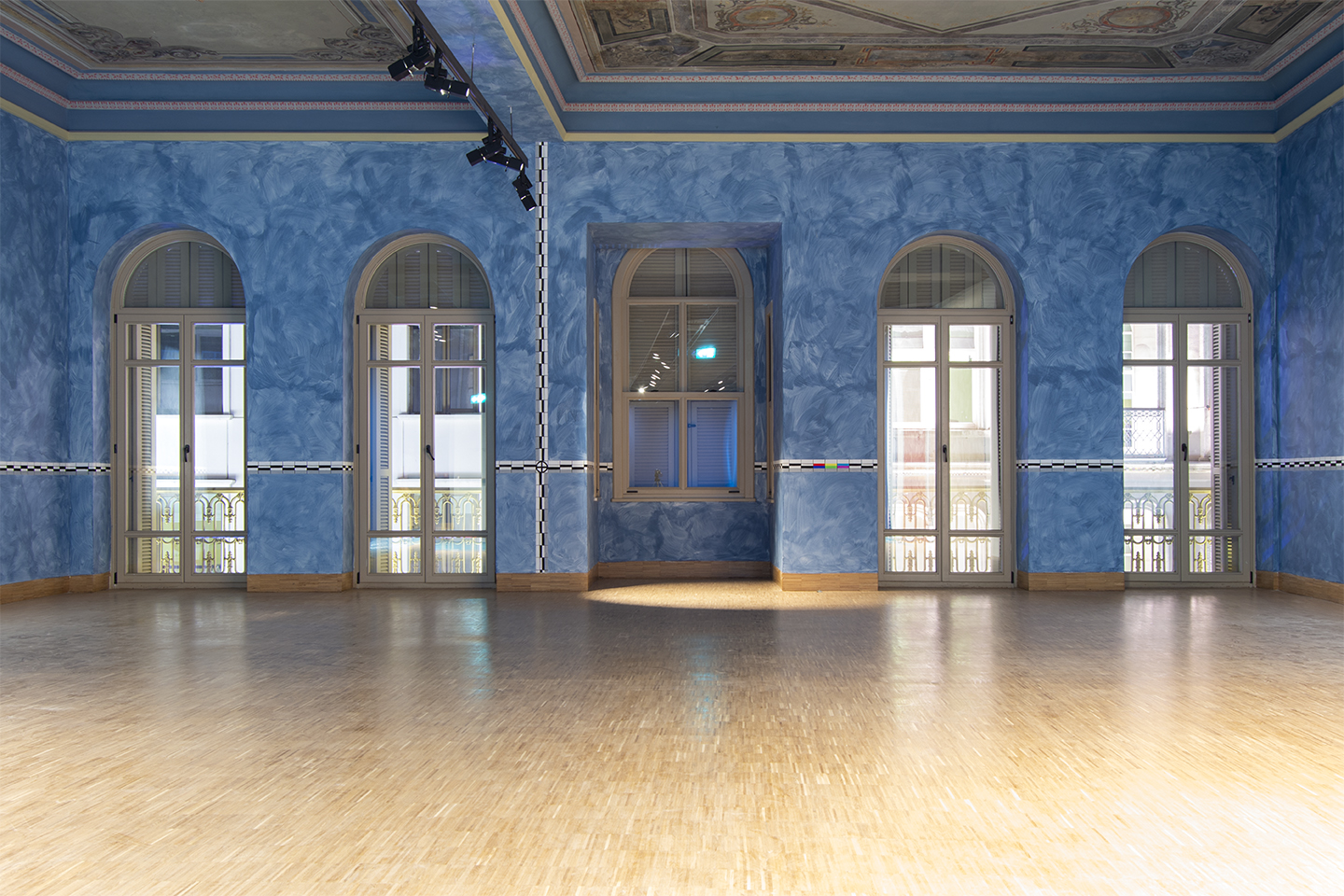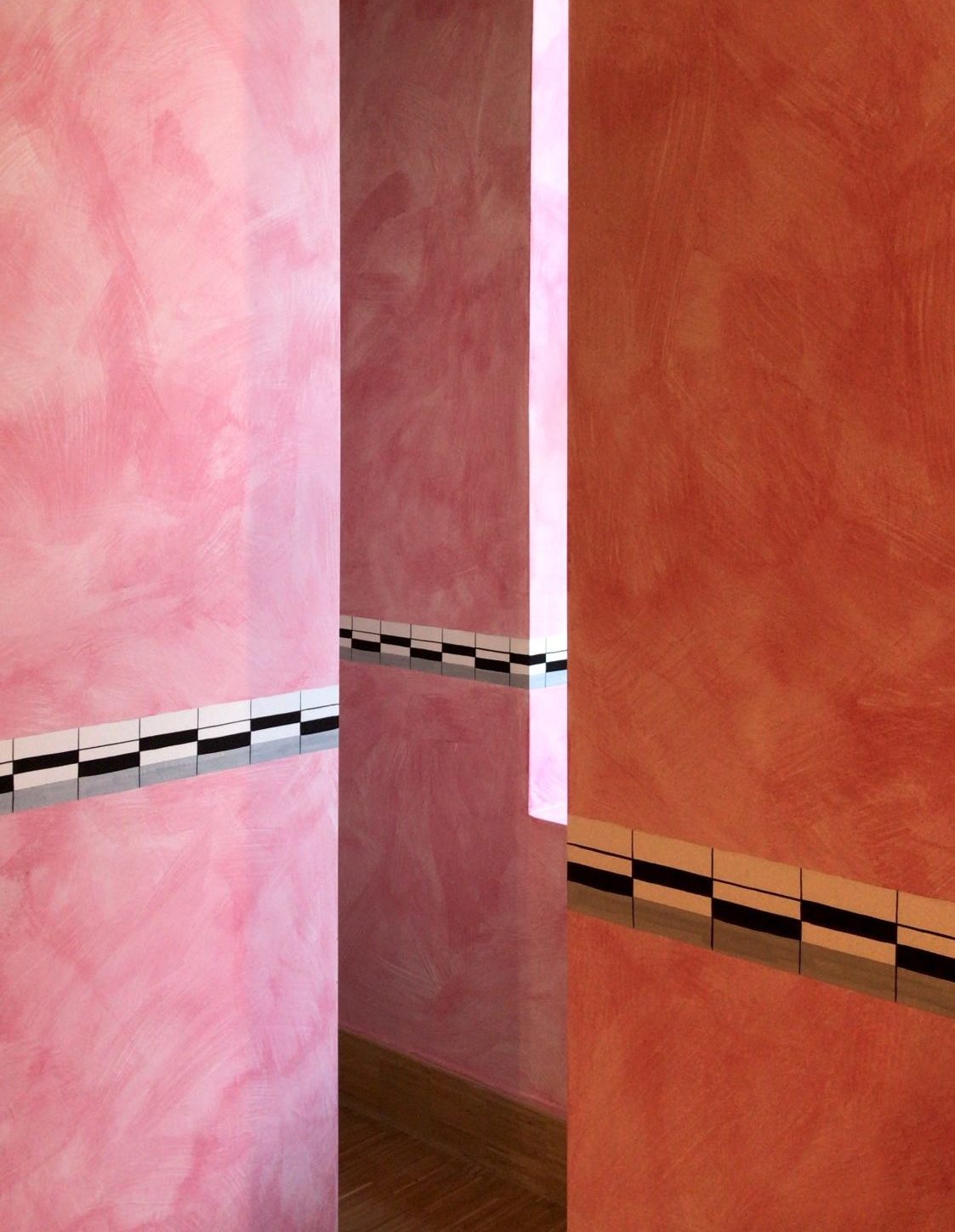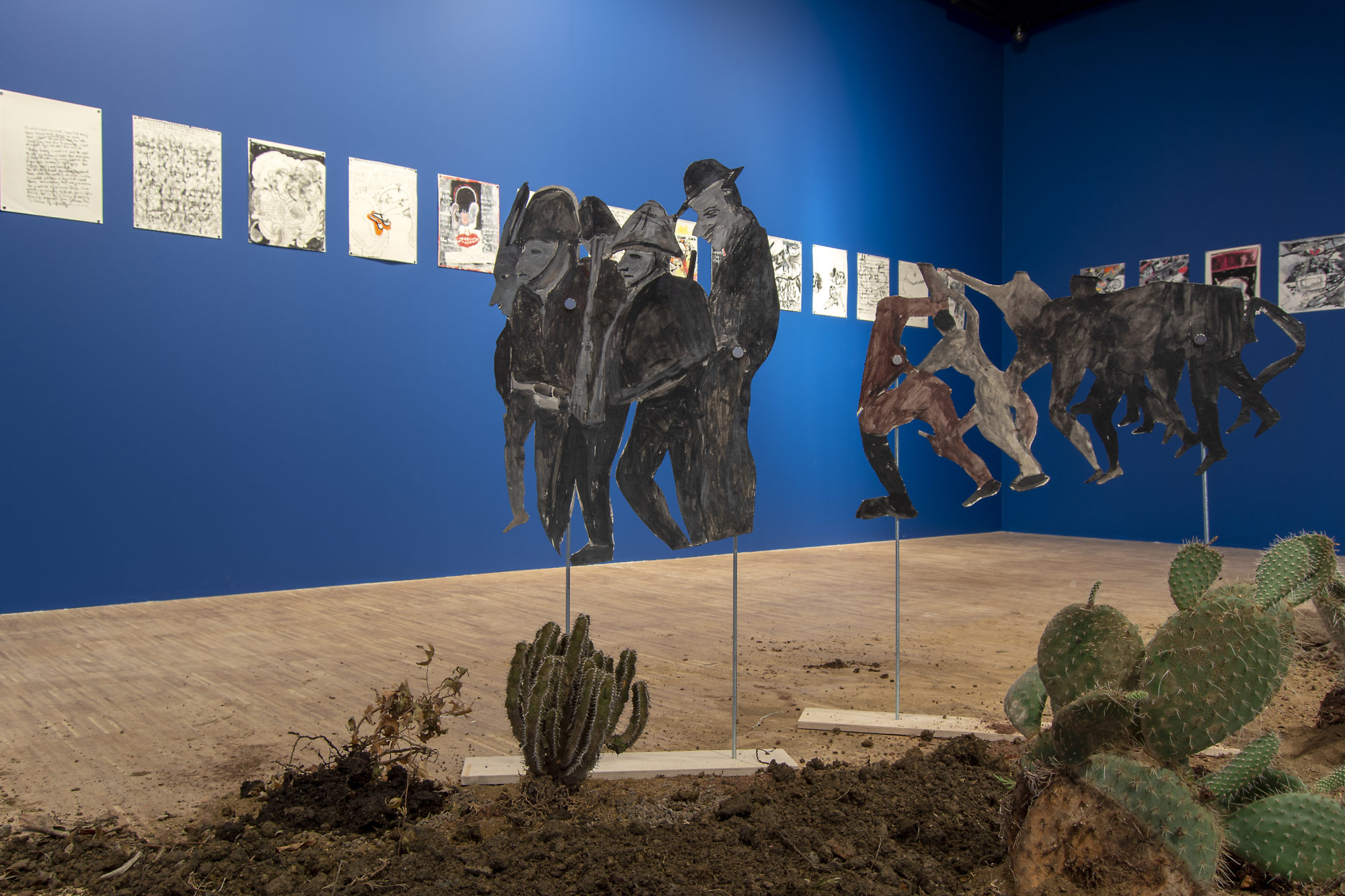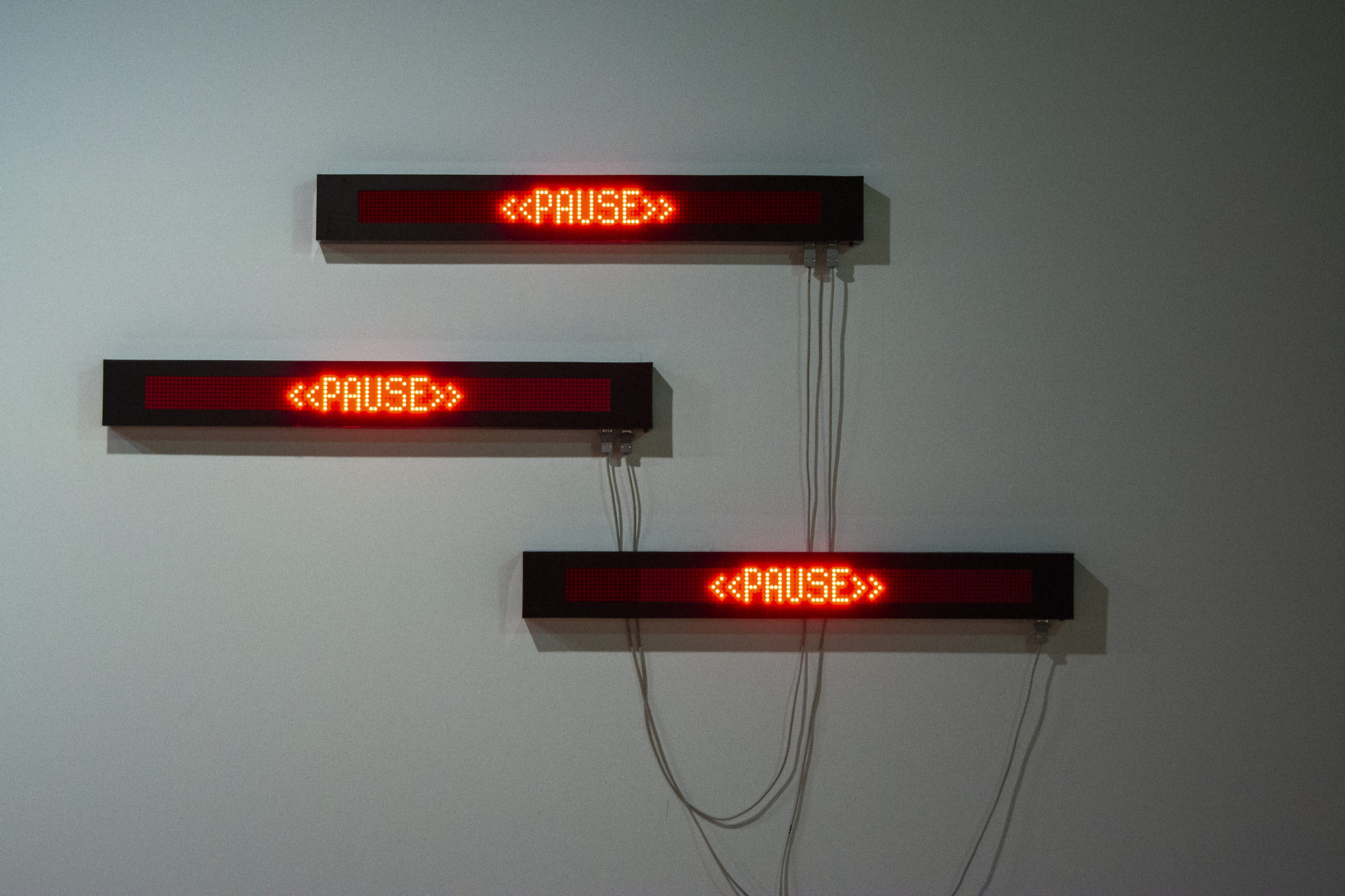The Universe Flickers

Navine G. Khan-Dossos, Scenes from a Pre-Crime (Performance for Security Guards), 2018, installation detail, dimensions variable [photo: Mustafa Hazneci; courtesy of the artist and SALT Beyoğlu, Istanbul]
Share:
“How do you create a record or generate matter in transitory times when the very limits of language, registers, and representation of truth are severely tested?” This is the question that The Universe Flickers poses to its audience, an exhibition that takes its title from a chapter in the 2014 Ken Liu translation of Cixin Liu’s science fiction novel The Three-Body Problem (2008), in which the story of China’s Cultural Revolution effectively becomes the basis for a dystopic vision of a future world programmed for self-destruction by those who gave up all hope for it.
The show brings together works by Anna Boghiguian, Rana Hamadeh, Navine G. Khan-Dossos, and Merve Ünsal. It opens in the Forum, the institution’s cavernous ground-floor entry space. There, Listening to SALT Beyoğlu (2018), Ünsal’s “sonic phonogram” of sounds collected from the SALT Beyoğlu site, offers an acoustic backdrop to Khan-Dossos’ site-specific intervention, Scenes from a Pre-Crime (Performance for Security Guards) (2018). Paying homage to the building’s former life as an apartment block built between 1850 and 1860, Khan-Dossos painted color blocks on the walls. From the ground level up to the third floor, light washes of color drawn from the building’s decorative ceiling murals include a pale salmon pink, a sky blue, and a creamy tan. Cutting through the middle of these blocks and bordering the sides of each is a line painted in the style of a forensic ruler—a measuring instrument used at crime scenes and in the judicial system. The purpose is to draw the domestic specter back into view, thus destabilizing the line between public and private, past and present, in an indictment on crimes that have been—and are yet to be—committed on both sides of the temporal and spatial divide.
On the first floor, encounters between domestic and public space continue in Ünsal’s two-channel video installation Outside Instead of Before (2018), which focuses on two windows in the Kağıthane district of Istanbul, a neighborhood that has been undergoing gentrification as part of state-supported “urban transformation projects.” Installed in a dark, closed-off room, the work consists of two scenes projected on opposite walls. In one, the camera focuses on the exterior of an apartment block, its view taking in, among other angles, a window with a white curtain and a balcony with a clothes rack on it. In the other, the camera’s gaze is trained on a massive construction site visible from the artist’s window, the different shifts in scenes—delineated by a blackout cut—identified by the time of day when the site was recorded. A script plays from speakers in the room. In Turkish, with an English translation presented in a booklet by the door, random observations are made audible. These include reflections upon a woman smoking on her balcony, the remembrance of “a different tongue in a different time and place,” and the contemplation of whether an eye can “un-see what the other eye has seen.”
Navine G. Khan-Dossos, Scenes from a Pre-Crime (Performance for Security Guards), 2018, installation detail, dimensions variable [photo: Gamze Cebeci; courtesy of the artist and SALT Beyoğlu, Istanbul]
The abstract nature of Ünsal’s script instills much the same sense of alienation in the viewer that the artist invokes in the views of Kağıthane—fragmented and remote. In contrast, a suite of paintings on paper by Boghiguian, though overwhelming and dizzying in number and density, seems to do the opposite, despite being equally abstract. Lining a majority of the wall in the first floor’s main gallery, How Minds Are Made (2010–2011) consists of some 80 painted drawings, most combining text and diagram––a selection presented for the first time in this show. Each picture represents a kind of furious, automatic writing in which Boghiguian offers a visual reflection of a mind processing the world through complex and subjective filters. In one drawing, a postal box at the center of the page has written on it the word “Cairo,” the city where Boghiguian was born to Armenian parents. Below, a story is scrawled in barely legible script. The narrative recalls a shift from agrarian to industrial culture, and a narrator who “went to work in a factory where they were building the future of our country,” where they “assembled parts of toys made in China, made cars, cameras, and many other things.”
Anna Boghiguian, How Minds Are Made, 2017-2018, installation detail, dimensions variable [photo: Mustafa Hazneci; courtesy of the artist and SALT Beyoğlu, Istanbul]
Although Cairo and Egypt take center stage in these drawings, scribbles quickly jump from context-specific to universally resonant. In one, the Middle East is considered a space everyone has passed through, from the Arabs to the Greeks. In another, the concept of the Middle East is countered by the region’s specificity, when the artist writes about how the people of the region are “called Middle Eastern,” yet “they all have their own Arabic, their own pronunciation, words, sentences, or behaviour.” In the same drawing, that subversion is subverted in turn with the mention of an older history, when the people of the region “all were once nomads.” Definitions collapse in profound ways in this spectacular and unruly installation. But while nothing is stable, there is one thing that feels certain in Boghiguian’s chronicle: “each person has his own brain,” she writes in one work, and it’s the one thing that feels universally true: we all see and feel the world through our own specific filters. This reality is expounded by the diagrams that collectively offer an insight into the artist’s mind, documents in which she demonstrates the depths to which our filters can take us, as we each take in—and interpret—the histories and experiences that have brought us into being. Boghiguian states in another work: “As I cross the boundaries of the world, I cross the boundaries of my mind.” As do we all.
To walk through Boghiguian’s installation, which includes a stunning set of paper cutouts of various figures and characters positioned over an island of dirt, like shadow puppets enacting a war, is to go through a conditioning. Borderlines between time and space, persona and collective, dissolve into something far more tangible: the state of uncertainty itself as a legitimate position. Curatorially, the show seems to lead to the exhibition’s crescendo: Hamadeh’s impressive installation for The Ten Murders of Josephine (The Tongue Twister) (2017–2018), a composition for an opera that is presented here as an automated, 10-channel installation, or, to quote the artist’s statement, “a networked system of interplaying parts.” Located on the third floor, the installation has one half of the gallery laid out like a stage, with much of the action revolving around an office desk with a telephone on it, next to which three LED screens installed on the wall offer text-narrations to accompany the sound recordings of singers performing the artist’s script.
Rana Hamadeh, The Ten Murders of Josephine (The Tongue Twiser), 2017-2018, installation detail, dimensions variable [photo: Mustafa Hazneci; courtesy of the artist and SALT Beyoğlu, Istanbul]
As a whole, Hamadeh’s opera seeks to destabilize the certainty—or finality—attributed to judicial law by challenging the validity of legal testimony. Structured around 10 murders, the script that unfurls over the LED screens takes viewers through a process of unravelling, in which forms of accepted truth are challenged with a level of absurdity that exposes the irrationality of certainty itself. The first murder is defined as “a call cut short,” “a command from a lord,” and “the theft of land”—with the LED script offering different roles that might apply to whoever is defining the murders themselves, such as “commentator,” “demonstrator,” and “violator.” The ninth murder is pinned to “a Voice that Kills,” which leads to the 10th murder, stated simply as “the Phonic—the voice AS the killer.” In this dramatic climax, everyone becomes implicated in a world where nothing is certain, and yet everything appears dangerously defined.
Stephanie Bailey is editor in chief of “Ocula” magazine, a contributing editor at “ART PAPERS,” and “LEAP,” and a regular contributor to “Artforum International,” “Yishu Journal of Contemporary Chinese Art,” and “Di’van: A Journal of Accounts.” Formerly the senior editor of “Ibraaz,” where she worked from 2012 to 2017, Bailey is also a member of the “Naked Punch” editorial committee; a managing editor of “Podium,” the online journal of M+ Museum in Hong Kong; and the current curator of Art Basel Conversations in Hong Kong.


